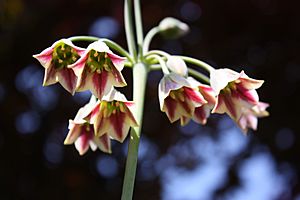Honey garlic facts for kids
Quick facts for kids Honey garlic |
|
|---|---|
 |
|
| Allium siculum | |
 |
|
| Allium siculum foliage | |
| Scientific classification | |
| Synonyms | |
|
Synonymy
Allium bulgaricum (Janka) Prodán
Nectaroscordum siculum (Ucria) Lindl. Nothoscordum siculum (Ucria) auct., published anonymously Trigonea sicula (Ucria) Parl. Nectaroscordum bulgaricum Janka Allium meliophilum Juz. Nectaroscordum meliophilum (Juz.) Stank. Allium dioscoridis Sm. Nectaroscordum dioscoridis (Sm.) Stankov |
Allium siculum is a unique plant known by many names. You might hear it called honey garlic, Sicilian honey lily, Sicilian honey garlic, or Mediterranean bells. It belongs to the Allium plant family, which also includes onions and garlic.
This plant naturally grows in areas around the Mediterranean Sea and Black Sea. People also grow it in other parts of the world. It is popular both as a beautiful garden flower and as a culinary herb for cooking.
Contents
What Does Honey Garlic Look Like?
Honey garlic plants grow tall, reaching up to 1.2 meters (about 4 feet) high. In May and early June, they show off pretty clusters of bell-shaped flowers. These flowers hang downwards in a graceful way.
Each flower is cream-colored with a maroon stripe down its petals. The tips of the petals are white and flare out. The base of the flowers has a green tint. After the flowers bloom, they turn into interesting, upright seed pods in late summer.
The leaves of the plant are blue-gray and have a triangular shape. They also twist strongly along their length. If you cut the plant, it releases a strong, somewhat skunky smell.
Where Does Honey Garlic Grow?
Allium siculum is native to several countries. You can find it growing naturally in Turkey, Crimea, Greece, Bulgaria, and Romania. It also grows in southern France, including the island of Corsica. In Italy, it's found in regions like Basilicata, Abruzzo, Umbria, Toscana, Sicily, and Sardinia.
This plant prefers to grow in damp, shady woods.
How Is Honey Garlic Used?
Growing Honey Garlic in Gardens
Honey garlic is a popular choice for flower gardens. Its showy, drooping flowers are quite striking. Each cluster of flowers, called an umbel, can have up to 30 individual blooms. These flowers can be white, pink, and green.
Interestingly, the flowers first face downwards. But just before they form seedheads, they turn to face upwards! The plant also has unusual twisted leaves. Unlike most other Allium species, honey garlic grows well even in shady spots.
Using Honey Garlic in Cooking
In Bulgaria, a type of honey garlic called Allium siculum subsp. dioscoridis is used in cooking. It's known there as 'samardala' or 'Bulgarian honey garlic'. People use its leaves to make spice mixes and seasoned salts. It's also used as a seasoning to add flavor to food.
Interesting Facts About Honey Garlic
Why Does it Make Your Eyes Water?
Just like onions can make your eyes water when you chop them, honey garlic does too! If you crush the plant, it releases special chemicals. These chemicals are called 'lachrymatory agents' because they make your eyes produce tears.
Scientists have studied these chemicals. One of them is similar to the chemical in onions that makes you cry.
Why Animals Don't Eat It
Allium siculum is usually not eaten by grazing animals like deer. This is probably because of its strong, garlic-like smell. Animals tend to avoid plants with such strong odors.
Is Honey Garlic Safe for Pets?
It's important to know that Allium siculum might be toxic to cats and dogs. Other plants in the Allium family can cause problems for pets. This is because they contain certain compounds that can harm red blood cells, leading to a condition called haemolytic anaemia. So, it's best to keep your pets away from honey garlic plants.

